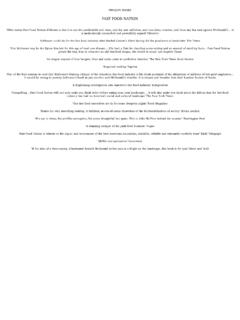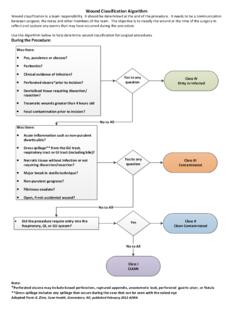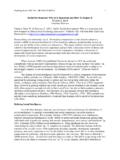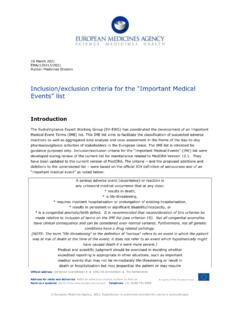Transcription of RAT DISSECTION GUIDE - philipdarrenjones.com
1 RAT DISSECTION GUIDE INTRODUCTION Rats are often used in DISSECTION classes because they are readily available and they possess the typical mammalian body plan. Most of what you learn on the rat is applicable to the anatomy of other mammals, such as humans. EXTERNAL FEATURES Refer to the drawing below and identify the indicated structure on the rat prior to skinning. Vibrissae - also referred to as the "whiskers". They have a sensory function that allows the animal to judge the size of an opening that it is about to pass through. Nares - the nares (plural) or naris (singular) are the external openings into the nasal cavity. Female urogenital structures Urethral orifice - is the opening into the urethra (part of the urinary system). Vaginal orifice - is the opening into the vagina (part of the reproductive system). Male urogenital structures Penis - is hidden on the male rat beneath a fold of skin (the foreskin or prepuce).
2 Scrotum - is a pouch that contains the testes (see the drawing below) Skinning the rat Make a midventral incision as illustrated on the drawing above. Use your probe, scissors and finger to free the skin from the underlying tissue. Follow the basic cut pattern illustrated on the first page of this handout. You should encounter two brownish muscles attached to the skin (the cutaneous maximus in the trunk area, and the platysma in the neck area). You will probably have to cut these muscles close to the skin before the skin can be removed. MUSCULAR SYSTEM The diagram below illustrates the muscles of the ventral surface of the rat. Be able to identify those listed. Use the photographs on the following pages and your lab atlas to assist you. Head and Throat muscles Digastric - this V shaped muscle follows the lower jaw line. It functions to open the mouth.
3 Mylohyoid - runs at right angles to the longitudinal axis. You may have to gently raise up the edge of the digastric muscle on each side of the jaw in order to see this muscle. It functions to raise the floor of the mouth. Sternohyoid - runs parallel to the longitudinal axis on either side of the midline. It functions to pull the hyoid towards the sternum. Sternomastoid - runs diagonally from the sternum to a point behind the ear. It functions to rotate the head to one side (when one contracts), or rotates the head down (when both contract). Masseter - this is the "cheek" muscle. It functions in mastication (chewing). Chest and Front leg (medial) muscles Pectoralis Major - the large triangular muscle covering the upper thorax. It functions to pull the arm towards the chest.
4 Pectoralis Minor - part of this muscle runs beneath the Pectoralis Major. It function is the same as the Pectoralis Major. Biceps Brachii - the large muscle located on inside of the upper arm. It functions to flex (bend) the lower arm. Epitrochlearis - this is a flat, thin muscle on the medial surface of the upper arm. It functions to extend the lower arm. Flexors - the collection of small muscles on the medial surface of the lower arm. They function to flex the wrist and hand. Shoulder and Lateral (outside) Muscles of the Front Leg Be able to identify the muscles illustrated on the drawing on the next page. Clavotrapezius - one of a group of three muscles that help to stabilize the scapula. Its function is to pull the clavicle forward.
5 Acromiotrapezius - pulls the scapula forward. Spinotrapezius - pulls the scapula downward. Latissimus dorsi - pulls the arm downward. Serratus ventralis - is made up of fingerlike projections of muscle running between the armpit and the ribs. Its function is to depress the scapula. Cleidobrachialis - runs between the clavicle and the humerus. Its function is to pull the arm forward. Acromiodeltoid - Runs between the outer clavicle and the scapula. Pulls the upper arm away from the ribs. Spinodeltoid - runs between the scapular spine and the upper arm. Pulls the scapula away from the ribs. Triceps brachii - this is a muscle with three heads. It runs between the scapula and humerus and the ulna. Its function is to extend the lower arm.
6 Brachialis - runs next to the Biceps Brachii. Its function is to flex the lower arm. Extensors - a group of small muscles on the lateral side of the lower arm. They extend the wrist and hand. Deep Muscles of the Shoulder Identify the deep muscles illustrated on the drawing above. Rhomboideus - runs between the dorsal border of the scapula and vertebral column. Its function is to pull the scapula in and forward. Supraspinatus - covers the lateral side of the scapula, above the scapular spine and attaches to the upper arm. Its function is to pull the upper arm forward. Infraspinatus - covers the lateral side of the scapula, below the scapular spine and attaches to the upper arm. Its functions is the rotate the upper arm outwardly. Teres Major - runs along the outer edge of the scapula to attach to the upper arm.
7 Its function is to rotate the humerus laterally. Hip and Lateral Muscles of the Hind Leg Identify the muscles illustrated on the drawing below. Gluteus Superficialis - covers a large portion of the anterior hip. Its function is to pull the thigh outward. Biceps Femoris - located posterior to the Gluteus. Its function is to pull the upper leg outward and flex the lower leg. Semitendinosus - it is located on the posterior margin of the leg and is partly hidden by the Biceps Femoris. Its function is to flex the lower leg. Gastrocnemius - the major "calf" muscle on the posterior surface of the lower hind leg. Its function is to extend the foot. Soleus - located under the Gastrocnemius. Its function is to extend the foot.
8 Tibialis Anterior - located on the anterior surface of the lower hind leg. Its functions is to flex the foot. Hip and Medial Muscles of the Hind Leg Be able to identify the following muscles illustrated on the drawing on page 3 of this handout. Gracilis - a flat muscle on the caudal (near the tail) portion of the inner thigh. Its function is to pull the thigh inward. Rectus femoris - located on the anterior (front) surface of the thigh. Its function is to extend the lower hind leg. Vastus medialis - runs parallel to the Rectus femoris on the caudal side. Its function is to extend the lower hind leg. Adductor Magnus and Brevis - runs parallel to and beneath the Gracilis. Its function is to pull the thigh towards the body.
9 Adductor Longus - runs parallel to and beneath the Vastus Medialis. Its function is to pull the thigh towards the body. Pectineus - located next to the femoral vein. Its function is to pull the thigh towards the body. Abdominal Muscles Be able to identify the following muscles illustrated on the drawing on page 3 of this handout. External Oblique - covers most of the ventral and lateral abdomen. Its function to compress and hold the internal organs in place. Rectus Abdominis - runs parallel to the longitudinal axis of the body on either side of the linea alba. Its function is to compress and hold the internal organs. Throat and Oral Cavity Be able to identify the structures illustrated on the drawing below. The structures indicated are components of a variety of organ system.
10 Parotid Gland - the major salivary gland. Its function is to secrete saliva containing starch digesting enzymes. Parotid duct - empties saliva from the Parotid Gland into the oral cavity. Mandibular gland - a salivary gland that secretes a thick mucous. Sublingual gland - a small salivary gland that empties into the oral cavity behind the lower incisors. Lymph Nodes - part of the immune system. Lacrimal Gland - secretes lacrimal fluid (tears) to lubricate the eye. The Abdominal Cavity and the Digestive System Be able to identify the structures illustrated on the drawing below. DISSECTION - use scissors to make a midventral cut up the entire length of the abdominal cavity. When you reach the diaphragm (a broad sheet of muscle that separates the thorax from the abdomen) make lateral cuts along the lower border of the rib cage.





